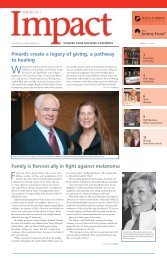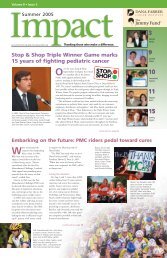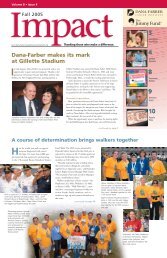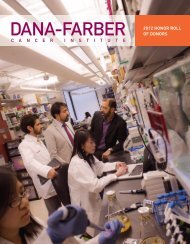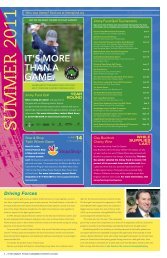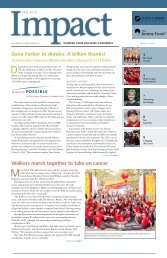Impact - The Jimmy Fund
Impact - The Jimmy Fund
Impact - The Jimmy Fund
Create successful ePaper yourself
Turn your PDF publications into a flip-book with our unique Google optimized e-Paper software.
Learn more about the Mission Possible Campaign at dana-farber.org/campaign.<br />
Renowned philanthropist’s newest cause hits close to home<br />
PMC continued from page 1<br />
For more than a decade, Steven Kirsch has given tens of millions of dollars<br />
to support medical research, education, environmental protection, and<br />
community-based charities. Committed to making the greatest possible<br />
impact with his gifts, he has always placed a premium on finding and supporting<br />
underfunded yet worthwhile<br />
projects. In August 2007, he found<br />
just such a cause in Waldenström’s<br />
macroglobulinemia—only this time,<br />
it was personal.<br />
“I had never heard of<br />
Waldenström’s before I was<br />
diagnosed with it,” he said. “I had<br />
to crack open the textbooks and do<br />
some research.”<br />
Kirsch was appalled to learn the<br />
deadly blood cancer receives almost<br />
no attention from government<br />
funding agencies or pharmaceutical<br />
companies because it is relatively<br />
rare. Scarce funding means few<br />
scientists study this “orphan”<br />
disease and, therefore, relatively few<br />
treatment options exist for patients.<br />
Determined to change that,<br />
Kirsch began a nationwide search<br />
for the most promising researchers<br />
in the field. He quickly decided<br />
on the only center in the world<br />
Michele and Steven Kirsch hope their support of Waldenström’s<br />
macroglobulinemia research will produce lifesaving treatments<br />
for patients with this rare disease.<br />
<strong>The</strong> good fight<br />
focused specifically on this disease:<br />
Dana-Farber’s Bing Center for<br />
<strong>The</strong> community of Middleton, Mass., came together to honor one of their own with<br />
Jack Fights Back, an inaugural event to raise funds for neuroblastoma research at<br />
Dana-Farber. Held April 6 at the Danversport Yacht Club in Danvers, Mass., the benefit<br />
was organized by Ron and Kim Supino, whose 9-year-old son Jack has successfully<br />
battled this cancer of the nervous system.<br />
Originally expecting a modest turnout, the Supinos were moved by the mass of neighbors<br />
and friends who attended, as well as local businesses that contributed more than<br />
70 items for the raffle and silent auction. At the end of the day, this swell of support<br />
carried Jack Fights Back to a fundraising total of more than $100,000—four times<br />
more than initial expectations.<br />
According to the family, no one was happier with the outcome than Jack himself<br />
(above), who, at one point during the event, took center stage for an impromptu<br />
performance of Elvis Presley’s “Jailhouse Rock.”<br />
Waldenström’s Macroglobulinemia. Impressed by what he saw, Kirsch and his<br />
wife, Michele, have given Dana-Farber $1 million to support the work of Irene<br />
Ghobrial, MD, in the Bing Center.<br />
In recognition of the Kirsches’ generosity, Ghobrial’s laboratory within the<br />
Bing Center has been named the Michele and Steven Kirsch Laboratory for<br />
Waldenström’s Research.<br />
<strong>The</strong> gift also represents an important contribution to Mission Possible: <strong>The</strong><br />
Dana-Farber Campaign to Conquer Cancer.<br />
A two-pronged attack<br />
When deciding which specific projects to fund, Kirsch was particularly drawn<br />
to Ghobrial’s work. One of the greatest obstacles in combating the disease is the<br />
ability of Waldenström’s macroglobulinemia cells to hide out in a patient’s bone<br />
marrow where they are protected from drugs designed to destroy them. Much of<br />
Ghobrial’s research focuses both on understanding how the cancer cells gain entry<br />
into the bone marrow and identifying drugs to force them out of their hiding<br />
places. Using such drugs, she hopes to first “smoke out” the cancer cells and then<br />
kill them with other treatments.<br />
“It’s a nice one-two combination,” said Kirsch. “<strong>The</strong> approach she’s taking<br />
appears the most promising to me.”<br />
In addition to supporting clinical trials based on this strategy, the Kirsch gift<br />
will fuel studies designed to help researchers better understand the basic biology<br />
of the disease and the causes of its progression. It will also fund projects aimed at<br />
identifying new drug targets and transforming that knowledge into novel therapies<br />
as quickly as possible.<br />
Without the Kirsches’ crucial support, many of these promising endeavors<br />
would never get off the ground.<br />
“<strong>The</strong> government doesn’t usually give much money for Waldenström’s<br />
macroglobulinemia research,” said Ghobrial. “This gift is huge in terms of helping<br />
me push our research forward.” n<br />
Bailey gift zeroes in on genetic<br />
roots of rare blood cancer<br />
When Robert “Bob” Bailey was first<br />
diagnosed with Waldenström’s<br />
macroglobulinemia in 1997, few<br />
treatments existed for this unusual illness. In the<br />
decade that followed, his therapeutic options grew,<br />
thanks in large part to Steven Treon, MD, PhD,<br />
director of the Bing Center for Waldenström’s<br />
Macroglobulinemia at Dana-Farber.<br />
“Dr. Treon has done so much for people with<br />
this disease,” said Bailey’s wife, Laura. “Because<br />
of him, there are now treatments that we never<br />
would have thought possible 10 years ago.”<br />
Hoping to build on that success, the Baileys<br />
have given Dana-Farber $750,000 to fund<br />
Treon’s research into the genetics of the rare<br />
blood cancer.<br />
In previous studies, Treon and his colleagues<br />
identified Waldenström’s patients with a family<br />
history of blood cell abnormalities. This subset<br />
of patients may have inherited genetic risk<br />
Robert “Bob” Bailey’s positive experience as a<br />
Dana-Farber patient inspired him and his wife,<br />
Laura, to support Waldenström’s macroglobulinemia<br />
research under the direction of Steven Treon,<br />
MD, PhD (above).<br />
factors that contribute to the development of the disease. With support from the<br />
Bailey Family <strong>Fund</strong>, Treon plans to study these patients and their families in the<br />
hopes of identifying specific genes underlying the illness—information that might<br />
yield important clues about what causes the cancer and how to treat<br />
it more effectively.<br />
“Research on this rare disease is chronically underfunded,” said Treon.<br />
“Without the generous support of people like the Baileys, important projects of<br />
this kind might never move ahead.”<br />
Research and care are major funding priorities of Mission Possible: <strong>The</strong> Dana-<br />
Farber Campaign to Conquer Cancer, and Bailey’s gift supports this<br />
$1 billion fundraising initiative.<br />
Bob Bailey’s survival 11 years after diagnosis is a testament to the power<br />
of DFCI’s ability to rapidly translate discoveries into new therapies to benefit<br />
patients. Already having lived longer than most people with his disease, he believes<br />
the development of new therapies has been crucial in helping him beat the odds.<br />
With this gift, the Baileys hope Treon will one day produce even better treatments,<br />
improving the odds for all Waldenström’s macroglobulinemia patients.<br />
“Obviously, we’re interested in helping a lot of people with this disease,” said<br />
Bob Bailey. “Dr. Treon is the right person, doing the right research, right now.” n<br />
line to collectively raise an anticipated, record-breaking $34 million.<br />
<strong>The</strong> PMC, founded in 1980 by Executive Director and Institute Trustee Billy<br />
Starr, is the largest athletic fundraising event in the nation. It is so well known<br />
that it now draws people from 36 states and eight countries who want to make a<br />
difference in the lives of cancer patients around the globe.<br />
“We at the PMC relish the role we play at Dana-Farber,” said Starr. “We feel<br />
challenged, but capable, of providing this incredible annual gift and, at the same<br />
time, challenged and flattered to find the room for all who want to participate in<br />
this amazing weekend event.”<br />
Thriving and surviving<br />
Paul Schaye, a devoted extreme-sports athlete and Boston native, has participated<br />
in the PMC for 10 years. His team, “Paul’s Posse,” has raised more than $712,000<br />
over the past two years alone. In October 2006, his reason for riding became more<br />
personal: He was diagnosed with stage IV stomach cancer.<br />
“In the past, I rode to help raise money for cancer research, but I never<br />
imagined I would ride as a possible beneficiary of that research,” he said.<br />
Referring to himself as a “cancer thriver,” Schaye faced his treatment with the<br />
same positive power he put into all of his athletic challenges. After major surgery<br />
in November 2007 and with the assistance of the “smart” drug Gleevec®, Paul<br />
remains disease-free. To celebrate this year, he again made the 190-mile journey<br />
with his Paul’s Posse teammates by his side.<br />
“We at the PMC relish the role we play <br />
at Dana-Farber.”<br />
— Institute Trustee Billy Starr<br />
<strong>The</strong> next generation<br />
<strong>The</strong> PMC has rapidly become an event for participants of all ages. Since 1998, the<br />
PMC Kids Ride Program has offered children between the ages of 3 and 15, as<br />
well as their parents and neighbors, the opportunity to create individual bike-athons,<br />
including a short obstacle course for tykes on tricycles and a 26-mile trek<br />
for teens.<br />
“Through these mini bike-a-thons, we are teaching children the benefits of<br />
being active and helping others,” Starr said. “<strong>The</strong> PMC Kids Ride Program is the<br />
future of the PMC.”<br />
In 2008, 30 kids rides were held and are expected to raise $750,000 toward the<br />
PMC’s impressive $34 million goal. n<br />
Left to right: Paul’s Posse team leader Paul Schaye celebrates being a “cancer thriver” with fellow<br />
teammates George Demetri, MD, director of DFCI’s Center for Sarcoma and Bone Oncology, Demetri’s<br />
daughter, Leah Demetri, and Julie Pokela.<br />
Cycling toward cancer cures<br />
More than 300 bicyclists pedaled along four different routes throughout Western<br />
Massachusetts as part of Katelynn’s Ride. Held June 8, the 8th annual fundraiser, which is<br />
affiliated with the Pan-Massachusetts Challenge bike-a-thon, raised $165,000 to benefit<br />
groundbreaking research and treatment at Dana-Farber Cancer Institute. This year’s success<br />
has helped the program surpass $1 million in cumulative fundraising since its inception.<br />
Katelynn’s Ride began in 2000 to honor 11-year-old Katelynn Battista, a <strong>Jimmy</strong> <strong>Fund</strong><br />
Clinic patient who lost her battle against cancer in 1997. Moved by her story, Steve<br />
Stark, of the United States Postal Service, and radio personalities Dan Williams and Kim<br />
Zachary of Mix 93.1-FM in Springfield, Mass., organized the event in her memory.<br />
Right: With his parents, Domenic and Michele Battista, by his side, Luke Battista kicked<br />
off this year’s festivities by cutting the ribbon at the starting line at Hampshire College in<br />
Amherst, Mass.<br />
One PMC cyclist shows his enthusiasm for fighting cancer while pedaling along one of the bike-a-thon’s<br />
various routes.<br />
Left to right: NECN television anchor R.D. Sahl speaks with PMC Founder and Executive Director and<br />
Institute Trustee Billy Starr during the event’s opening ceremonies, which included a check presentation<br />
from younger riders of the PMC Kids Ride.<br />
6 <strong>Impact</strong> SUMMER 2008<br />
<strong>Impact</strong> SUMMER 2008 7




